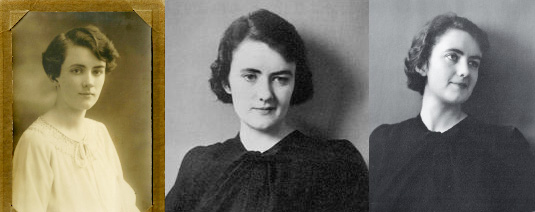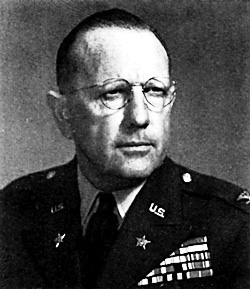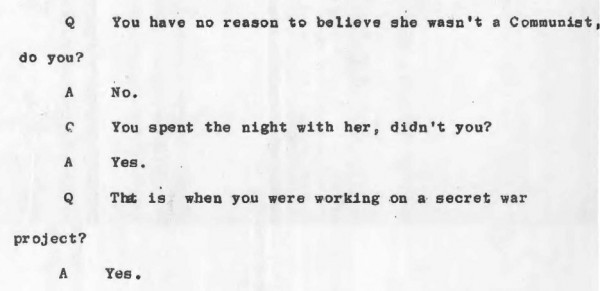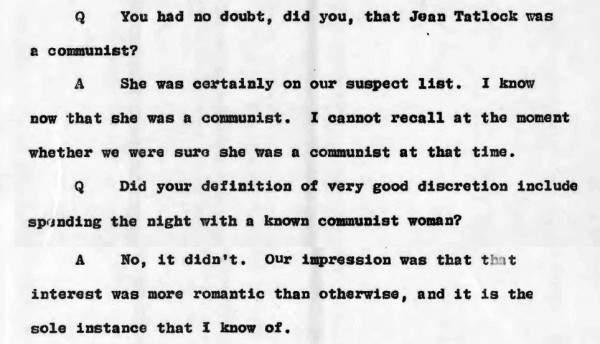The most recent episode of Manhattan, 209, is the penultimate episode for Season 2. There were many aspects that pleased me a lot, in part because I saw my own fingerprints on them: the discussion between Frank and Charlie about the possibility of a demonstration, and Charlie’s later coming around to the idea that the best thing you could do for the future was to make the use of the first atomic bombs usage as terrible as possible; the full-circling of the subplot involving the patent clerk; the tricky politics of the Target Committee. But my favorite part was that the Jean Tatlock subplot finally paid off. The idea that Jean Tatlock might have been murdered by intelligence agents working for Manhattan Project security sounds like a crazy conspiracy theory, a totally imaginative take by the writers of the show. But there’s potentially more to it than just that.

Three photographs of Jean Tatlock. The one at left and right come from the website of Shirley Streshinsky and Patricia Klaus’s An Atomic Love Story, a book about Oppenheimer’s loves; the one in the middle comes from Kai Bird and Martin Sherwin’s American Prometheus.
Jean Tatlock is an interesting and curious character. In most narratives about the life of J. Robert Oppenheimer, she shows up with two purposes: to radicalize him, and to humanize him. He put his relationship this way in his security hearing of 1954:
In the spring of 1936, I had been introduced by friends to Jean Tatlock, the daughter of a noted professor of English at the university; and in the autumn, I began to court her, and we grew close to each other. We were at least twice close enough to marriage to think of ourselves as engaged. Between 1939 and her death in 1944 I saw her very rarely. She told me about her Communist Party memberships; they were on again, off again affairs, and never seemed to provide for her what she was seeking. I do not believe that her interests were really political. She loved this country and its people and its life. She was, as it turned out, a friend of many fellow travelers and Communists, with a number of whom I was later to become acquainted.
I should not give the impression that it was wholly because of Jean Tatlock that I made leftwing friends, or felt sympathy for causes which hitherto would have seemed so remote from me, like the Loyalist cause in Spain, and the organization of migratory workers. I have mentioned some of the other contributing causes. I liked the new sense of companionship, and at the time felt that I was coming to be part of the life of my time and country.
One, of course, doesn’t take such a statement fully at face value, being made, as it was, ten years after her death, and in the middle of a hearing on whether Oppenheimer himself was loyal to the country. It is an interesting fact, as an aside, that it was Tatlock who broke off the official relationship, in 1939, rejecting an offer of marriage. He got seriously involved with Katharine (Kitty), his future wife, a few months later.
Tatlock’s name pops up in the Oppenheimer security hearing a number of times, and proved a rather tricky, if not embarrassing, issue for Oppenheimer. Oppenheimer admitted that he had visited Tatlock in San Francisco in June of 1943. It was a secret visit, approved by nobody, at the time when Oppenheimer was director of Los Alamos. Oppenheimer was being tailed by intelligence agents during the entire trip, however. A few choice selections from the transcript:
Oppenheimer: I visited Jean Tatlock in the spring of 1943. I almost had to. She was not much of a communist but she was certainly a member of the party. There was nothing dangerous about that. There was nothing potentially dangerous about that. …
Q: Doctor, between 1939 and 1944, as I understand it, your acquaintance with Miss Tatlock was fairly casual, is that right?
JRO: Our meetings were rare. I do not think it would be right to say our acquaintance was casual. We had been very much involved with one another and there was still very deep feeling when we saw each other. … I visited her, as I think I said earlier, in June or July of 1943.
Q: I believe you said in connection with that that you had to see her.
JRO: Yes.
Q: Why did you have to see her?
JRO: She had indicated a great desire to see me before we left [for Los Alamos]. At that time I couldn’t go. For one thing, I wasn’t supposed to say where we were going or anything. I felt that she had to see me. She was undergoing psychiatric treatment. She was extremely unhappy.
Q: Did you find out why she had to see you?
JRO: Because she was still in love with me.
Q: Where did you see her?
JRO: At her home. …
Q: You spent the night with her, didn’t you?
JRO: Yes.
Q: That was when you were working on a secret war project?
JRO: Yes.
Q: Did you think that consistent with good security?
JRO: It was as a matter of fact. Not a word — it was not good practice.
All of the above was discussed at the security hearing with Kitty present in the room. Ouch.
Later, they asked Lt. Col. John Lansdale, Jr., the head of Manhattan Project security, about Tatlock and Oppenheimer:
Q: You had no doubt, did you, that Jean Tatlock was a communist?
Lansdale: She was certainly on our suspect list. I know now that she was a communist. I cannot recall at the moment whether we were sure she was a communist at the time.
Q: Did your definition of very good discretion include spending the night with a known communist woman?
L: No, it didn’t. Our impression was that interest was more romantic than otherwise, and it is the sole instance that I know of.
Tatlock, according to the standard version of the story, suffered from intense depression and killed herself in January 1944. Her love of John Donne may have been why Oppenheimer named the first test for the atomic bomb “Trinity.” We don’t know; even Oppenheimer claimed not to know. It makes for a good story as it is, a poetic humanization of a weapons physicist and the first atomic test. Peer De Silva, the head of security for the Los Alamos laboratory, later wrote that he was the one who told Oppenheimer of Tatlock’s death, and that he wept: “[Oppenheimer] went on at considerable length about the depth of his emotion for Jean, saying there was really no one else to whom he could speak.” 1
But there may be more to the story. Gregg Herken’s Brotherhood of the Bomb (Henry Holt, 2002) was the first source I saw that really peeled apart the Oppenheimer-Tatlock story, and got into the details of the 1943 visit. Oppenheimer had told security he was visiting Berkeley to recruit an assistant, though Tatlock was always the real reason for the trip. He was being tailed by G-2 agents the entire time, working for Boris Pash, who was in charge of Army counterintelligence in the Bay Area. They tailed Oppenheimer and Tatlock to dinner (Mexican food), and then followed them back to Tatlock’s house. Army agents sat in a car across the street the entire night. The assistant that Oppenheimer hired was David Hawkins, who had his own Communist sympathies. The whole thing was a very dodgy affair (in many senses of the term) for the scientific head of the bomb project. Pash subsequently got permission to put an FBI bug on Tatlock’s phone. 2

Oppenheimer at Los Alamos. Source: Emilio Segrè Visual Archives.
More recently, and more sensationally, there is an entire chapter on Tatlock’s death in Kai Bird and Martin Sherwin’s biography of Oppenheimer, American Prometheus (Knopf, 2005). They suggest that there is evidence that Tatlock’s death might not have been a suicide at all — that it might have been an assassination, murder. Now, just to make sure we are clear, they go to lengths to suggest that the evidence is not clear, and that their argument is speculative and circumstantial. But I also want to point out that Bird and Sherwin aren’t cranks: I know them both personally and professionally, and they are serious about their craft and research, and the chapter on Tatlock’s death, like the others in their book, is meticulously documented. The book itself won the Pulitzer Prize, as well. So this is not something that should be easily dismissed.
Bird and Sherwin paint a messy picture. Tatlock’s father discovered her dead, having broken into her apartment after a day of not being able to reach her. He found her “lying on a pile of pillows at the end of the bathtub, with her head submerged in the partly filled tub.” He found her suicide note, which read: “I am disgusted with everything… To those who loved me and helped me, all love and courage. I wanted to live and to give and I got paralyzed somehow. I tried like hell to understand and couldn’t… I think I would have been a liability all my life—at least I could take away the burden of a paralyzed soul from a fighting world.”
John Tatlock moved her body to the sofa, rummaged through the apartment to find her correspondence, and burnt it in the fireplace. He spent hours in the apartment before calling the funeral parlor, and it was the funeral parlor who called the police. The cause of death was drowning. To quote from Bird and Sherwin directly:
According to the coroner, Tatlock had eaten a full meal shortly before her death. If it was her intention to drug and then drown herself, as a doctor she had to have known that undigested food slows the metabolizing of drugs into the system. The autopsy report contains no evidence that the barbiturates had reached her liver or other vital organs. Neither does the report indicate whether she had taken a sufficiently large dose of barbiturates to cause death. To the contrary, as previously noted, the autopsy determined that the cause of death was asphyxiation by drowning. These curious circumstances are suspicious enough—but the disturbing information contained in the autopsy report is the assertion that the coroner found “a faint trace of chloral hydrate” in her system. If administered with alcohol, chloral hydrate is the active ingredient of what was then commonly called a “Mickey Finn”—knockout drops. In short, several investigators have speculated, Jean may have been “slipped a Mickey,” and then forcibly drowned in her bathtub.
The coroner’s report indicated that no alcohol was found in her blood. (The coroner, however, did find some pancreatic damage, indicating that Tatlock had been a heavy drinker.) Medical doctors who have studied suicides—and read the Tatlock autopsy report—say that it is possible she drowned herself. In this scenario, Tatlock could have eaten a last meal with some barbiturates to make herself sleepy and then self-administered chloral hydrate to knock herself out while kneeling over the bathtub. If the dose of chloral hydrate was large enough, Tatlock could have plunged her head into the bathtub water and never revived. She then would have died from asphyxiation. Tatlock’s “psychological autopsy” fits the profile of a high-functioning individual suffering from “retarded depression.” As a psychiatrist working in a hospital, Jean had easy access to potent sedatives, including chloral hydrate. On the other hand, said one doctor shown the Tatlock records, “If you were clever and wanted to kill someone, this is the way to do it.” 3
Interesting — but not in any way conclusive. What becomes more suspicious is when you look a bit more at the person who might have been most interested in Tatlock being “removed from the picture”: Lt. Col. Boris Pash, chief of the Counterintelligence Branch of the Western Defense Command (Army G-2 counterintelligence). A Russian immigrant to the United States who had fought on the losing side of the Russian Civil War, Pash was regarded by fellow Russian émigré George Kistiakowsky as “a really wild Russian, an extreme right wing, sort of Ku Klux Klan enthusiast.” 4

Boris T. Pash, head of West Coast G-2 during the war, and later head of the Alsos mission. Image from the Atomic Heritage Foundation.
Aside from bugging Tatlock’s apartment, Pash attempted to get Oppenheimer fired as a potential spy, during the war. He worried that even if Oppenheimer wasn’t himself spying, he might be setting up people within his organization (like Hawkins) who could be spies, with Tatlock as the conduit. He was overruled by Lansdale and Groves, both of whom trusted Oppenheimer. Pash would later be given the job of being the military head of the Alsos mission — to better to harass German atomic scientists rather than American ones? 5
In his memos about Oppenheimer and Tatlock, Pash comes off as fearful, hyperbolic, and hyperventilating. He did not see this as a matter of idle suspicion, but intense danger. After his recommendations were ignored, could he have taken things into his own hands? It’s a big claim. What seems to give it the whiff of credence is what Pash did after the war. In the mid-1970s, during the Church Committee hearings about the mis-deeds of the CIA, it came out that from 1949 through 1952, Pash was Chief of Program Branch 7 — which was responsible for assassinations, kidnappings, and other “special operations,” but apparently did not perform any. 6
Could Pash, or someone working for him, have killed Tatlock? Probably not Pash himself: in November 1943 (two months before Tatlock’s death), he was already in Europe organizing the Alsos mission. The records indicate that in late December 1943 through mid-January 1944, Pash was in Italy. It’s not very plausible that he’d have raced back to San Francisco for a “side mission” of this sort. 7 Would someone else in G-2, or the Manhattan Project intelligence services, be willing and capable of doing such a thing? We don’t know.
Might Tatlock’s death just really have been what it appeared to be at first glance — a suicide? Of course. Bird and Sherwin conclude that there just isn’t enough evidence to think anything else with any certainty. What does it do to our narrative, if we assume Tatlock’s death was not a suicide? It further emphasizes that those working on the bomb were playing at a very dangerous game, with extremely high stakes, and that extraordinary measures might have been taken. The number of lives on the line, present and future, could seem staggeringly large. Just because it makes for a good story, of course, doesn’t make it true. But from a narrative standpoint, it does make for a nice area of historical ambiguity — just the kind of thing that a fictional, alternate-reality version of the bomb project, like Manhattan, is designed to explore.
- Peer De Silva, Notes on an unwritten manuscript titled “The Bomb Project: Mysteries That Survived Oppenheimer,” (ca. Spring 1976), copy received from Gregg Herken, who in turn was given them by Marilyn De Silva in 2002.[↩]
- Gregg Herken, Brotherhood of the bomb: The tangled lives and loyalties of Robert Oppenheimer, Ernest Lawrence, and Edward Teller (New York: Henry Holt and Co., 2002), 101-102.[↩]
- Kai Bird and Martin J. Sherwin, American Prometheus: The triumph and tragedy of J. Robert Oppenheimer (New York : A.A. Knopf, 2005): chapter 18.[↩]
- George Kistiakowsky interview with Richard Rhodes (15 January 1982), transcript reproduced on the Manhattan Project Voices website.[↩]
- Bird and Sherwin, chapter 16.[↩]
- Bird and Sherwin, chapter 16. Separately, in an executive (Top Secret) hearing before the Church Committee in 1975, Pash disputed that he was ever an employee of the CIA (“I was never an employee of the Agency. I was detailed from the Army for a normal tour of duty to the Agency.”) and that the unit he was part of “was not an assassination unit.” In the same testimony he did, however, emphasize how rag-tag American counterintelligence was during World War II, having called up a lot of reserve units like himself — he was a schoolteacher originally — sending them briefly to have training with the FBI, and then sending them out into the field extremely fresh. On the early CIA, Pash said: “So, when the CIA was formed, a lot of those people with these wild ideas and wild approaches were there. So of course when you say you’re in charge of all other activities in individual activities, and these fellows might have ideas well, you know, like we did maybe in World War II, I heard they did something like that, well, it’s easier to kill a guy than to worry about trailing him, you see. So maybe that is where something originated.” (The not-entirely-clear phrasing is in the original transcript.) He went on to say that at one point an idea of assassination was floated when he was conveniently out of town, but that his office had rejected it. The testimony is not entirely clear on timing issues, and Pash goes out of his way to emphasize his lack of memory from the period, urging that his time with the CIA was mostly spent planning operations, but not actually carrying them out. Testimony of Boris T. Pash at an Executive Hearing of the Select Senate Study of Governmental Operations with Respect to Intelligence Activities (7 January 1976). As with all of this kind of spy stuff, it can be very hard to sort out who is telling the truth. There are motives upon motives for giving inaccurate portrayals of things in one direction or the other. Many of the allegations against the CIA and Pash came originally from E. Howard Hunt, who is a character of some impressive slipperiness. Pash emphatically denied most of what Hunt said, and insinuated that it might be part of a disinformation campaign, or something Hunt was doing for personal profit. Hunt, in his own executive session testimony, said that Pash himself had a reputation for kidnappings when he worked in the CIA, not assassinations. Interestingly, Hunt told the committee that the reason he had remembered Pash’s name, all those years later, was because he had been reading Nuel Pharr Davis’ book, Lawrence and Oppenheimer (Simon and Schuster, 1968) — which strikes me as a bit meta, having walked down this rabbit hole from another Oppenheimer biography. Confronted with Pash’s denial, Hunt equivocated a bit, not calling Pash a liar, but suggesting that some of what he heard about Pash might not be entirely accurate, but sticking to the basics. It makes for an interesting read. Testimony of E. Howard Hunt at an Executive Hearing of the Select Senate Study of Governmental Operations with Respect to Intelligence Activities (10 January 1976). The Church Committee staff concluded that while Pash’s group may have had assassinations and kidnappings as part of its responsibility, it performed none of them and did not plan any. Apologies for the digressive footnote, but I thought this was too interesting not to share, or to include the documents in question![↩]
- There are numerous memos and requisition orders written by Pash in Correspondence (“Top Secret”) of the Manhattan Engineer District, 1942-1946, microfilm publication M1109 (Washington, D.C.: National Archives and Records Administration, 1980), Roll 4, Target 1, Folder 26, “Files Received from Col. Seeman’s Section (Foreign Intelligence),” Subfile 26N, “Alsos Mission to Italy.”[↩]




It is obvious that you put a lot of time and effort into this. I appreciate it. What’s the process you use to locate these kinds of documents, seems like reading the books and footnotes? Have you ever gone and watched these microfilms?
Thanks again and have a good weekend
Books, footnotes, original documents in archives, microfilms, FOIA requests, FBI files, Congressional testimony, online databases, interviews with retired scientists — the whole shebang. It’s a full-time job (one I’m fortunate to have) to immerse myself in this kind of stuff.
I figured it took as much. I’m happy that you get to pursue it and share it with us. Did you receive my snail mail and consider modifying your model? Take care Alex and keep it up! If you ever pursue Russian and Chinese development let me know, I would be happy to assist with translation, etc.
Tatlock and Oppenheimer seem to be birds of a feather, neurotic and sociopathic at a high level. Each probably had numerous liaisons/affairs, and their risk-taking behaviors must have driven the counterintelligence guys like Pash crazy.
Looking forward to the season finale this coming week. Great post.
Did Jean Tatlock kill herself, or was her death brought about by someone else? This looks like an either/or question, but sometimes in situations like this, a both-and answer is possible. In reading Henry James’s story “The Turn of the Screw,” for instance, one is likely to suppose either that the governess is crazy, or that the ghosts are real, but as a teacher of mine once pointed out, both may be true.
In the case of Jean Tatlock, it’s likely that appearances are correct and that she did kill herself, but then there are those telltale bits of evidence and argument that may allow you to believe she was killed and the result staged to mislead investigators. Suicide is certainly plausible, but in a way the murder theory is too. It’s rather hard to imagine drowning yourself in a tub, even with the calculated help of chloral hydrate, which I’d think would be hard to get right on the first try. Although Virginia Woolf apparently managed to calmly walk into a river, this kind of deliberate drowning is rare, to judge from my research into suicide. And yet Tatlock’s note sounds authentic, speaking in a voice of regret and pain and self-recrimination. Who could’ve forged such a thing?
What’s really interesting, though, at least from a dramatic point of view, is the both-and possibility: maybe Tatlock did kill herself, but under the influence of an outside party. Boris Pash doesn’t sound capable of such persuasion, and besides he seems to have been elsewhere at the time, but maybe someone else could’ve done it.
I hope I haven’t gone overboard or sounded cavalier in anything I’ve said. Suicide and murder are horrible to contemplate, just as the deaths at Hiroshima and Nagasaki are, but the grim extremity of such things is part of what drives the investigations of history and the dramatizations of fiction.